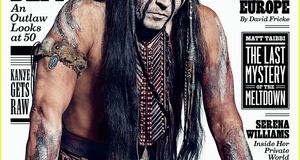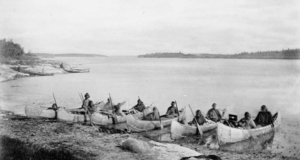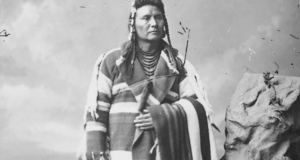Featured Article:Controversial Kin: Transracial Adoption in "Hope Leslie" and "Ramona"Transracial Adoptions and Ramona’s Reform RhetoricWhen Helen Hunt Jackson took up the Native American’s cause, she too would underline how much more inclusive and transformative Native American adoption practices were. Whereas Hope Leslie simply highlights this, Jackson’s Ramona proposes that the nation could mimic Native American adoption practices in order to make a more racially inclusive America. Furthermore, Ramona would argue that those being adopted did not need to wipe out their cultural history in order to be accepted as members of the adoptive society. As an indefatigable Indian sympathizer and Indian policy reformer, Jackson first authored A Century of Dishonor (1881), a muckraking-style non-fiction work that sharply criticized the American government’s actions against Native Americans, but when A Century of Dishonor did not receive the attention Jackson thought it would, she then wrote and published Ramona three years later. With its use of a half-Native American, half-Scottish girl as the protagonist, the text attempts to hand Native Americans back their voice from the “voiceless obscurity” of manifest destiny, nineteenth-century American imperialism, and Indian removal (Sedgwick, 1827, p. 352). Whereas transracial adoptions in Hope Leslie are presented as anything but adoptions, transracial adoptions in Ramona are presented clearly as such, and the subject becomes a great center of interest for the text. The novel begins with a failed love story that produces failed parenthood: Angus Phail, the well-off “owner of the richest line of ships which traded along the coast,” aggressively courts Senorita Ramona Gonzaga, who does not love him, but eventually agrees to marry him (Jackson, 1884, p. 33). When Phail returns, he discovers that his bride has married another man, Senor Ortegna. Out of grief, Phail disappears into an Indian tribe and marries “a squaw” (Jackson, 1884, p. 36). Meanwhile, Senora Ortegna is unable to have children in her own marriage, so when Phail shows up at her doorstep with his half-Indian, half-Scottish infant, she accepts his entreaty that she raise his daughter Ramona, named after her. Although the adoption is successful on one account because Senora Ortegna loves and cares for the child, it fails when Ramona is abandoned again by the death of her guardian at only four years of age. Before her death, Ortegna extracts a promise from her sister Senora Moreno that she would take the jewels Phail had given her and that “she would adopt the little Ramona” (Jackson, 1884, p. 40). Despite the fact that Moreno dislikes Ramona’s mixed-blood, she does provide care for her in the household. But at the same time, Moreno withholds affection and love from Ramona, tainting her supposed act of kindness. Shortly after Hope Leslie was published, the Jackson administration passed the Indian Removal Act of 1830, which forced the majority of Native Americans in southeast tribes to move to Oklahoma reservations and allowed white settlers to buy the Native Americans’ former land at cheap prices (Carlson and Roberts, 2006, p. 487). However, the nation was not only putting Indian removal policies on the books; the government was also recognizing the phenomenon of adoption and how adoptions should be carried out. By the time Ramona was published in 1884, the 1851 Massachusetts Adoption of Children Act had been enacted; it was the first law in the modern world to formally address adoption and was especially distinctive because of its emphasis on the child’s well-being. It stated among other things that “the petitioners,” or future adoptive parents, had to be of “‘of sufficient ability to bring up the child’” (Kawashima, 1984, p. 678).The cause of Ramona’s first adoption is unusual because she was not an orphan at the time she was adopted, was not born out of wedlock, and her father was wealthy enough to support her financially. Orphanhood, illegitimacy, and/or financial problems were and are some of the most common reasons for adults or the state to adopt children out to families other than their biological one, both in nineteenth-century America and even in today’s twenty-first century society. Senora Ortegna notes thus how “strange” this adoption is (Jackson, 1884, p. 37). And later on the novel, even Ramona questions the reasons for her adoption. “‘Was my mother dead?’ continued the child. …‘Because if she is not dead I would ask her why she did not want me to stay with her’” (Jackson, 1884, p. 55). But the real reason for Phail’s actions, however, soon comes out. The adoption is done “partly in vengeance” because of Ortegna’s earlier betrayal of Phail (Jackson, 1884, p. 37). He reminds her, “You sinned, and the Lord has punished you. He has denied you children,” but then adds, “I have sinned, and the Lord has punished me. He has given me a child” (Jackson, 1884, p. 36). In return for her sin of treachery, she would remain childless. However, the result of his sin, the sin of miscegenation with an Indian woman, is the resulting child from the relationship. But the fact that the young Ramona still has fit parents makes Ortegna question the legitimacy of the adoption. An “embarrassment came upon her [and] looking down upon the infant, she said inquiringly, ‘But the child’s mother?’” (Jackson, 1884, p. 37). With this query, Ortegna acknowledges that this adoption, if enacted, would sever the familial bond between mother and child. However, Phail completely discounts any natural right Ramona’s mother has to her “[w]ith a quick wave of his hand, which spoke volumes” and he articulates, “That is nothing. She has other children, of her own blood. This is mine, my only one, my daughter. I wish her to be yours” (Jackson, 1884, p. 37). Phail’s hand here symbolizes his power as a man to marginalize his wife’s maternal and even legal bond with her own child, and he accompanies this by saying their bond is “nothing” (Jackson, 1884, p. 37). Phail then emphasizes that it is only the children of one’s own blood and race that one can care about or have a right to (“She has other children, of her own blood.” In contrast, “This is mine.”) This paradoxically delegitimizes the very adoption Phail is trying to convince Ortegna to participate in, since she is being asked to adopt a child that is not hers and is not her same race. Furthermore, it also implies that Ramona’s mother has the right to take care of her children of Indian blood, but she has no authority over her child of mixed-blood race, since the white European Phail has laid claim to Ramona based on his blood ties and his racial and gender superiority. His series of descriptions decreases in significance of how he claims her: Ramona is first described as a kind of possession that he has the right to control (“This is mine”), then by the uniqueness of her blood ties with her white father (“my only one”), and then by a gendered familial affiliation with him (“my daughter”) (Jackson, 1884, p. 37). When describing Ramona, Phail can only speak in the language of blood, saying nothing about how he has raised or cared for her as a measure of parenthood. Thus, Ramona portrays blood and genealogical ties as masculine and paternalistic, and instead of these blood ties being associated with the stable, familial unit of the home, they are associated with displacement for reasons other than what is best for the child. With this conversation between Senora Ortegna and Phail, Ramona sets down a definite dichotomy: blood is a masculine concern, but care and responsibility for the innocents of society is a feminine concern. I would argue that Jackson sets up this transracial adoption between Phail and Ortegna and the following adoption between Ortegna and Moreno in this way as a representation of America’s reprehensible past with Indian removal policies. In A Century of Dishonor, Jackson (1881) discusses repeatedly the implications of early nineteenth-century forced removal for Native American tribes: “To dwell on the picture of this removal [the removal of a tribe of Cherokees in 1835 to the Western side of the Mississippi] is needless … No imagination so dull, no heart so hard as not to see and to feel, at the bare mention of such an emigration, what horrors and what anguish it must have involved” is just one example. (p. 286). Critics, of course, have often pointed out how Jackson’s sentiments toward Indian removal played out in Ramona. Yet, most critics point this out only after Ramona marries Alessandro rather than to her adoption and early life. Kate Phillip’s (2006) comment in Helen Hunt Jackson: A Literary Life is typical: “From the time Ramona and Alessandro leave the Moreno estate, a juncture that occurs almost exactly in the middle of the novel, their story becomes one of wandering exile” (p. 257). In other words, the majority of scholarship on Ramona states that Ramona becomes deprived of her agency and displaced after she marries and moves around with Alessandro. To argue this, though, requires readers to ignore the fact that throughout the beginning of the text, Ramona is shuffled around to different households as a mixed-race female orphan with extremely minimal privilege in society. These transracial adoptions, in so much as they take away the little agency a child had and that they jarringly remove Ramona from one place to another, thus mirror what Jackson considered failed and dishonorable Indian removal policies enacted in the 1830s through the 1840s. As I have already discussed, Ramona makes clear that Ramona’s first adoption is not a natural or normal one. In no way was it done for the child’s well being, which the 1851 Adoption of Children Act had previously codified should be the ultimate purpose for adopting out children. Angus Phail justifies adopting out Ramona by negating her natural right to be with her Native American mother and claiming the adoption is an equal trade off for everyone (“I have sinned” and “you have sinned”). In the same way, the two administrations that enacted removal policies in the nineteenth century—Andrew Jackson’s and Martin Van Buren’s—tried to justify Indian removal policies by asserting that because the American government had “a title” to the land “independent of their will,” they could remove the Native Americans regardless of their “unquestioned right to the land they occup[ied]” (Peters, 1831, p. 161). In other words, the government negated the Native American’s natural right to the lands, their land being a kind of “mother” to the tribes.1 And through her portrayal of adoption, Jackson rebukes the most ludicrous governmental notion of them all: the notion that removal was an equal trade for all those involved, including the Native Americans. Jackson pointed out that in an 1838 Secretary of War document, Hugh Garland, the Clerk of the House of the Representatives, writes: “in carrying out in this instance with an unwavering hand the measures resolved upon by the Government, in the hope of preserving the Indians and of maintaining the peace and tranquillity [sic] of the whites, it will always be gratifying to reflect that this has been effected not only without violence, but with every proper regard for the feelings and interests of that people [i.e. the Cherokees]” (Century of Dishonor, 1881, p. 285, emphasis added). But Ramona assures readers that when a wealthy white patriarch removes a child, an agent-less being from their home, it is an action done for the remover’s benefit, not the child’s. Phail discusses in length issues of blood because, in the microcosm of the family, blood is equivalent to race in the larger macrocosm of the nation. Here there are obvious parallels; Angus Phail represents a racist white government; Ramona represents the agent-less Native American tribes, who could be removed whenever it fit the paternalistic government’s needs. It is well known that Jackson (1884) created Ramona to be a character white readers could sympathize with; hence, her skin “had just enough of olive tint” to “underlie and enrich her skin without making it swarthy” and “her eyes were like her father’s, steel-blue” (p. 66). In other words, Jackson depicts Ramona as just Indian enough to make her point, but also white enough to comply with the tastes of her white audience. Ramona also portrays its key character as intelligent, hard working, and pious—even saintly—in order to complete an idealistic picture of the Native Americans. But not many analyses of this text have taken into consideration how Angus Phail is depicted in order to further carry out Jackson’s reform message. When Phail as a character is examined, the parallels between him and the government as well as the government policies Jackson harshly criticized begin to surface. In his opinion on the Cherokee Nation v. Georgia case, Justice John Marshall writes, “Their relation to the United States resembles that of a ward to his guardian. They look to our government for protection; rely upon its kindness and its power; appeal to it for relief to their wants; and address the president as their great father (Peters, 1831, p. 161, emphasis added). At the head of this domestic relationship, where the government provided “parental” guidance and Native Americans were the “children,” sat the great father, President Andrew Jackson. Jackson was of Scotch-Irish heritage and correspondingly Ramona’s father was “well-born in Scotland” (Ramona, 1884, p. 43). And even if this resemblance is completely coincidental or simply out or racism toward Scots in America, the fact still stands that government officials saw the American administration as a “father” to the Native Americans. Jackson exploits this belief in her portrayal of Phail; through him she suggests that the “great father” was doing wrong by his children by removing them from their home. Even Phail’s name suggests an either intentional or inadvertent slippage of language in Ramona: Phail fails Ramona as a parent, just as the American government failed the Native Americans with Indian removal policies.Continued on Next Page » Suggested Reading from Inquiries Journal
Inquiries Journal provides undergraduate and graduate students around the world a platform for the wide dissemination of academic work over a range of core disciplines. Representing the work of students from hundreds of institutions around the globe, Inquiries Journal's large database of academic articles is completely free. Learn more | Blog | Submit Latest in Literature |
















